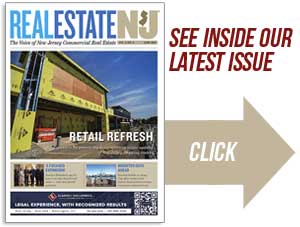By Michael G. McGuinness

On the last day of February this year, I had the distinct pleasure of listening to the presentations delivered by the eight teams of finalists for NAIOP’s annual Deal of the Year competition that is part of the annual Commercial Real Estate Awards Gala. It was as if I had been transported into a book of short adventure stories involving raw entrepreneurship, high-level politics, international travel, catastrophes, frustration, laughter, sleepless nights and even a tornado. Better than anything you could find in a bookstore, we heard from the consummate Jersey dealmakers, who are experts in their trade. They shared the methodologies, secrets and tribulations that led to their success in bringing fresh ideas to fruition in places that were not always ready to accept them.
What struck me most about these deals was the collaborative nature and level of cooperation that is taking place among all the participants in both the public and private sectors. It wasn’t always this way. Doing deals and development projects in the ’80s and ’90s was far more adversarial. What happened? I believe that local governments are finally realizing that they will soon become history if they don’t embrace the changing markets, economics, demographics, technologies, lifestyle demands and consumer preferences of the younger generations. From north to south, there is a greater willingness to rebrand themselves and do what it takes (such as increased density, rental housing, rezoning, etc.) to ensure their economic futures.
More towns are recognizing all the other benefits of (re) development, including the cleanup of contaminated sites, workforce and affordable housing, re-energized downtowns with arts districts and new modern buildings and infrastructure that are attractive to businesses and the many jobs they offer to their residents. This in turn increases tax revenues and often boosts the amount of charitable and philanthropic contributions that provide many beneficial services to the town. For example, the nine municipalities represented among the Deal of the Year finalists — Piscataway, Elizabeth, Perth Amboy, Logan, Lawrenceville, Whippany/Hanover, New Brunswick, Paramus and Parsippany — will see an influx of more than 7,000 full-time jobs and close to another 4,000 construction jobs with the completion of these projects. Nearly all these deals utilized PILOT agreements with the towns or received state incentives under the Grow New Jersey or ERG programs. Our decision makers in Trenton should take careful note of this.
If we just focus on the industrial deals, there are other factors at play that are leading to numerous successful projects in record time. Since New Jersey ranks as the third-largest industrial market in the U.S., the scarcity of readily available and accessible sites for industrial users has resulted in a red-hot market with few signs of slowing down. Investors and capital are plentiful, given the state’s vast logistics network of highways, rail and air, freight and deep-water cargo ports, along with consistent tenant demand and our unparalleled access to a dense affluent consumer base. Given this market, even the more difficult and challenged sites are getting cleaned up, stabilized and converted to e-commerce and distribution centers and warehouses. The low-hanging fruit is gone. Environmental contamination, poor geotechnical soil conditions, wetlands, lack of infrastructure and other obstacles — as complex and difficult as they are to navigate — are no longer a deterrent to getting these facilities up and running in this type of market.
Very different dynamics are at play in the suburban office markets in the older inner ring of Essex and Bergen counties and newer outer ring of Morris, Somerset and Mercer counties. Certainly, the more enlightened municipal leaders are collaborating with savvy developers to help them reimagine and transform their communities. Coincidentally, many of these office park makeovers are being designed around a central hub, a collaborative meeting place where people come to dine, shop, work out, be entertained, have a drink, read and socialize. Sam Morreale of Vision Real Estate Partners has often stated that “young people today want to earn the way they learned — in a college campus-type setting.” Use of a central hub facilitates this setting, as does the appeal and “dynamism of a city where people and ideas collide unpredictably,” a phrase coined by Nicholas de Monchaux, a Berkeley Professor and author of “Spacesuit.” It’s about time that many of these antiquated car-centric office parks were revitalized and rebranded to incorporate more urban amenities to attract today’s workforce and consumers — millennials and Generation Z. To paraphrase Kevin Welsh of Newmark Knight Frank from a recent Real Estate NJ story on Morris Corporate Center IV in Parsippany, “Institutions are now honing in on very high-quality value-add, where they can reposition the property and create an environment that is rich in amenities and collaborative.”
Working together to create something new and better is exciting. As described above, collaboration leads to many good things. In addition to helping clean up the environment and boosting quality of life, it is also good for our pocketbooks and wallets. Those involved in successful projects do their due diligence and invest considerable time in understanding what’s important to the community, along with the nuances and culture of area residents and businesses. All of this year’s NAIOP Deal of the Year finalist teams had this in common. As a result, securing the needed approvals, permits and funding moved along steadily to completion and provided much needed ratables and jobs to the towns, as well as income and other taxes to the state. Over time, as more investors, businesses and workers see a shift away from old thinking, antiquated land use standards and zoning, excessive taxes and fees, rigid building codes and political roadblocks, the state may be able to rely less on incentives.
None of these successful projects would have been possible without high-quality professionals. We have a deep bench of them, enabling developers to fast-track their projects by carefully selecting the right team of architects, engineers, consultants, planners, attorneys and financiers. The development teams who successfully deliver these complex and challenged sites are at the top of their game. They seem to have a Buddha-like ability to let nothing bother them as they navigate the myriad permits, approvals, setbacks, disasters and unplanned emergencies that always crop up. Whether it’s assembling the capital stack for financing or installing a roadway, or undertaking extensive geotechnical soil stabilization measures using controlled modulus columns, they get the job done. Together with the developers, these teams of professionals have in-depth knowledge of New Jersey real estate and a successful track record that inspires confidence in their financial partners and government officials.
I learned a lot that day from many folks who are part of Jersey’s A-team for commercial real estate. Here goes: “Shame on you if you don’t take advantage of a good market;” “Do business with the people you know, you like and you trust;” “Your reputation is key, so don’t screw up.” Real estate is a people business. Enough said.
Michael McGuinness is CEO of NAIOP New Jersey and has guided the commercial real estate development association’s progress since he joined the staff in 1997. In addition to overseeing daily operations, programs and staff, McGuinness directs the chapter’s legislative activities and manages the Developers Political Action Committee (DPAC).









